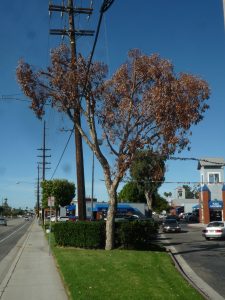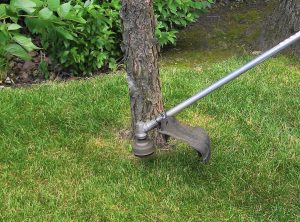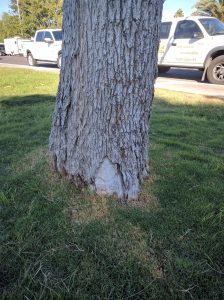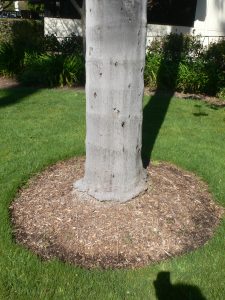It seems so simple to plant a tree. But to grow a tree is more difficult! In many parts of the United States there is enough water for trees and turfgrass, but it is often a bad idea to mix the two. You may have observed that sometimes young trees do not grow as well when planted in turfgrass. Certainly this is a generalized view and tree/turfgrass genetics are very different between their respective species. So it is natural to expect different outcomes when planting different species of trees in any landscape setting, turfgrass notwithstanding. Another factor to consider is time. The day we plant a tree is not the same time reference as ten years later. In ten years, the tree if it is successful, may have modified

its environment significantly, making turfgrass cultivation more difficult. Most tree/turfgrass difficulties begin when the tree is young–as a newly planted tree. If it succeeds in growing a large canopy, difficulties will ensue for the turfgrass. Sometimes turfgrass cultural requirements (frequent irrigation) can predispose trees to root or root-collar diseases such as Phytophthora.
Trees and turfgrass have some similar and very different requirements from their respective landscape settings. Both trees and turfgrass require sunlight to photosynthesize and grow. Both would usually prefer full sunlight without shade. As trees grow they shade the turfgrass sward beneath their canopies. Turfgrass can lose density, and become a thinner sward that is more susceptible to diseases such as powdery mildew. Trees grow roots near the soil surface and as they become larger, some trees may even proliferate roots near the mowing height of turgrass and suffer repeated injury from mowers, also increasing the risk of pest invasion into the tree. Both trees and turfgrass need water and soil minerals to grow. While soil minerals are usually abundant enough for both, water is often limiting for one or the other in this landscape combination.

The maintenance practices required for turfgrass often injure trees, especially young trees. Mowing near trees can injure the bark on the lower stem especially if the mower comes to close and actually scrapes the young stem. Since grass will grow longer where the mower can’t reach right near a tree stem there is a temptation to use a string line trimmer or weed whip to maintain the grass that has shot up around the tree stem. The repeated use of string line trimmers around trees removed young bark and can “girdle” the tree stem. While trees can survive these practices their growth rates are slowed considerably.

One approach to having trees growing with turfgrass is to remove a ring of turf away from the tree and replace it with mulch. This eliminates the need to maintain the turfgrass near the trees stem and root flare. Richard Harris and others (1977) found many years ago that a one foot circle removed around the stem of newly planted trees would increase their establishment rates compared to trees with turfgrass growing right near the stem. Whitcomb (1979) also recognized that turgrasses are competitors with newly planted shade trees. Whitcomb’s earlier research (1973) showed reduction in root density when trees were planted in a sward of Kentucky bluegrass.

As trees grow it is important to widen the ring around them giving more room for mulch and reducing the competing turfgrass underneath their expanding canopies. This is a general concept; some trees can live in turfgrass without problems as long as resources are not limiting. Riparian trees such as sycamore can grow well in swards of turfgrass, but other species such as Peruvian pepper (Schinus mole) tend to languish.
Trees are adapted to drop leaves, this is termed litterfall and it becomes part of their natural mulch. Litterfall tends to prevent annual plants such as grasses from developing. Fallen leaves, fruit and twigs are recycled by fungi providing nutrients back to the tree. Turfgrass cultivation interrupts this process and while trees obtain some of the nutrients supplied to turfgrass, as Whitcomb observed, turfgrasses are fierce competitors for nutrients so young trees are especially susceptible to nutrient deprivation in turfgrass swards. For the best results in your

garden, it is best to maintain some distance between young trees and turfgrass. It is optimal if the mulched (no turf) area under a tree can expand to its dripline as it grows.
Along with the other competition cited, allelopathy is a factor. Root exudates from fescue etc. are weapons in a chemical warfare against trees.
Allelopathy in the field has never been shown to exist. Only in labs and pot studies. Not an issue in real life. This article is specifically on juglone but the same holds true for any supposed allelopathic chemical. https://pubs.extension.wsu.edu/do-black-walnut-trees-have-allelopathic-effects-on-other-plants-home-garden-series
Maybe dicamba and picloram, or excessive application rates of other broadleaf weed control herbicides, can be a problem for trees. Helpful info for some golf courses and cemeteries, where grass is valued as highly as the trees. Helpful to know that riparian trees tend to do better with grass. I’ve seen the upland oaks suffer.
The home I recently bought has well-established trees (sugar maple, silver maple, spruce, birch) that the previous owner did not mulch around. They allowed the turfgrass to grow right up to the roots and trunk. Would a 4″ or more layer of wood chip mulch kill off the turf grass (without having to dig and weed it out) but not damage the tree? In other words, if the mulch is piled right up against the trunk, at least for a season or two?
Walter we never advocate placing mulch against the stem of landscape trees. mulch should be very thin or absent from the root collar. Weather mulch will kill turfgrass depends on the turf species that is present. Generally warm season tuffs will grow through and cool season grasses will be killed by think 4″ plus thick mulch layers.
Thanks for the quick reply. I’ll whittle away at the grass, to keep the trees safe!
Please also see this post from several years ago. It is based on published research on deep mulch for controlling weeds without damaging landscape plants. https://gardenprofessors.com/how-to-get-rid-of-your-lawn/
Thanks, Linda, for pointing me to this post, too. So I’ll use deep woodchip mulch where I can but thin it down up close the the established tree trunk. I may have to do a some hand weeding there, but it won’t be as big a project as digging turf in a 3- or 4-foot radius around the established trees! And, I won’t try to tackle all dozen trees at the same time or in one season. 😉